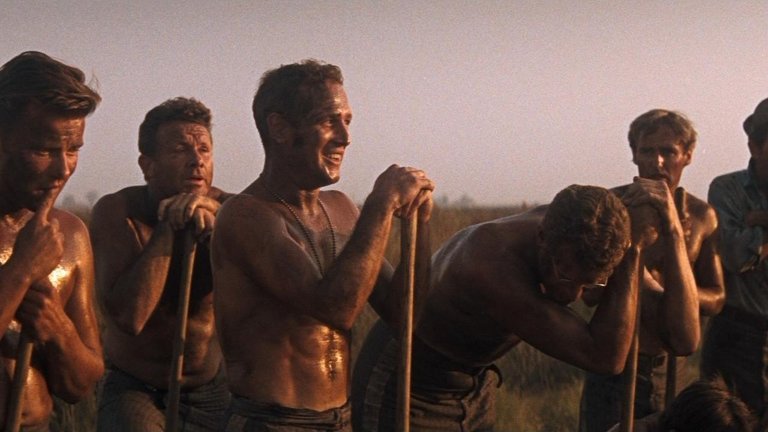
The 1960s marked a cultural watershed in which traditional hierarchies and societal norms were vigorously contested, a shift even reflected in Hollywood’s output. While the decade is often synonymous with the counterculture movement and the rise of the Baby Boomer generation, some of its most iconic films projected an anti-establishment ethos without overtly aligning with these trends. Cool Hand Luke, directed by Stuart Rosenberg in 1967, stands as a prime example. Though firmly rooted in the prison film genre, it transcends its confines to become a meditation on rebellion, authority, and individualism, cementing its status as a classic that resonates far beyond its era.
The film adapts Donn Pearce’s 1965 semi-autobiographical novel, informed by the author’s own two-year incarceration for safecracking. Set in an unnamed Southern U.S. state, Cool Hand Luke follows Lucas “Luke” Jackson (Paul Newman), a World War II veteran whose aimless post-war life culminates in a drunken act of vandalism—destroying parking meters—for which he is sentenced to two years on a prison farm. Initially an aloof figure, Luke’s latent defiance surfaces during a clash with Dragline (played by George Kennedy), the brutish, illiterate enforcer who rules the chain gang. Their boxing match, a ritual of dominance, becomes a defining moment: though physically overpowered, Luke’s refusal to yield transforms him into a folk hero among the prisoners and earns even Dragline’s respect and friendship. His rebellion escalates as he confronts the prison’s sadistic hierarchy, embodied by the drawling, tyrannical Captain (played by Strother Martin). When Luke escapes after learning of his mother’s death, his recapture triggers a cycle of punishment and resistance that oscillates between martyrdom and futility. Even as his spirit is systematically crushed, his final, doomed escape—joined by a loyal Dragline—cements his mythic status among the men.
For Baby Boomers coming of age in the 1960s, Luke’s defiance of authority—embodied by Newman’s magnetic performance—struck a chord. Though Newman was a generation older than his core audience, his portrayal of a man who “just can’t stay down” became a proxy for youthful disillusionment with institutional power. The script, co-written by Pearce and Frank Pierson, leverages regional stereotypes of the South as a backward, quasi-feudal realm, a perception amplified by contemporaneous televised clashes over civil rights. Yet the film avoids explicit political commentary, framing Luke’s rebellion as a personal crusade rather than a collective uprising. This focus on individualism—a man’s right to assert autonomy against dehumanising systems—aligned with the Boomer generation’s burgeoning emphasis on self-determination, ensuring the film’s place in the 1960s cinematic canon.
Paradoxically, Cool Hand Luke feels curiously detached from the decade’s radical aesthetics. Its plot, steeped in timeless themes of oppression and resistance, could plausibly unfold in the 1950s, while Rosenberg’s direction leans toward classical Hollywood formalism rather than New Wave experimentation. Yet the film is unmistakably a product of its time, thanks to Conrad Hall’s lush colour cinematography—which bathes the prison’s sun-scorched landscapes in a hazy, almost mythic glow—and Lalo Schifrin’s eclectic jazz score. Schifrin’s soundtrack, with its brassy swagger and melancholic undertones, bridges the gap between the story’s rural setting and the urbane cool of the 1960s, anchoring the film in its cultural moment.
The film’s legend rests largely on Paul Newman’s shoulders. Already a megastar, Newman embraced roles that subverted his matinee-idol image, and Luke Jackson ranks among his most nuanced anti-heroes. Luke is no visionary revolutionary; he is impulsive, self-destructive, and increasingly aware of his own futility. His rebellion is less ideological than existential—a refusal to be commodified by a system that reduces men to labouring beasts. Newman layers this complexity with a potent mix of vulnerability and roguish charm, culminating in a performance that invites both admiration and pathos. The film’s religious symbolism—Luke as a Christ figure sacrificing himself for the “sins” of his fellow prisoners—aligns with late-1960s cinema’s penchant for tragic, morally ambiguous endings, as seen in Newman’s subsequent hit, Butch Cassidy and the Sundance Kid (1969). It is Newman’s ability to humanise this archetype, to make Luke’s stubbornness feel noble rather than foolish, that ensures the character’s immortality.
Newman is ably supported by a formidable ensemble. George Kennedy, who won an Oscar for Best Supporting Actor, delivers a career-redefining turn as Dragline, transitioning from stock villain to a character of surprising depth. His evolution from Luke’s adversary to acolyte is rendered with rough-hewn authenticity, a testament to Kennedy’s underrated range. Strother Martin, as the Captain, epitomises petty authoritarianism, his folksy menace crystallised in the immortal line, “What we’ve got here is failure to communicate”—a phrase that entered the cultural lexicon as shorthand for institutional hypocrisy.
Yet the film’s tonal balance is not flawless. Newman’s natural levity offsets the bleakness, but other attempts at humour falter. The infamous car wash scene, in which a voluptuous blonde (played by Joy Harmon) sensually washes a car while prisoners gawk, now feels jarringly exploitative. This sequence, with its voyeuristic gaze and tonal dissonance, undermines the film’s gravitas, evoking the lurid excesses of B-movies rather than the psychological depth of a prestige drama.
In conclusion, Cool Hand Luke remains a landmark of 1960s cinema, its exploration of defiance and conformity rendered with poetic intensity. While its style may lack the radical edge of its contemporaries, its thematic resonance—bolstered by Newman’s iconic performance and a sterling supporting cast—secures its place in the pantheon. The film’s flaws, notably its occasional tonal missteps, are eclipsed by its strengths: a searing critique of institutional dehumanisation, a haunting allegory of martyrdom, and a testament to the indomitable, if quixotic, human spirit. Over half a century later, Luke’s struggle to “get his mind right” continues to echo as a parable of resistance in an age of conformity.
RATING: 7/10 (+++)
Blog in Croatian https://draxblog.com
Blog in English https://draxreview.wordpress.com/
InLeo blog https://inleo.io/@drax.leo
Hiveonboard: https://hiveonboard.com?ref=drax
InLeo: https://inleo.io/signup?referral=drax.leo
Rising Star game: https://www.risingstargame.com?referrer=drax
1Inch: https://1inch.exchange/#/r/0x83823d8CCB74F828148258BB4457642124b1328e
BTC donations: 1EWxiMiP6iiG9rger3NuUSd6HByaxQWafG
ETH donations: 0xB305F144323b99e6f8b1d66f5D7DE78B498C32A7
BCH donations: qpvxw0jax79lhmvlgcldkzpqanf03r9cjv8y6gtmk9
Posted Using INLEO
